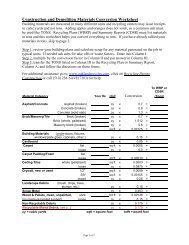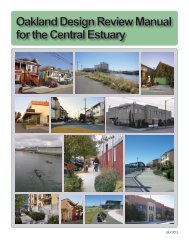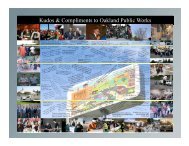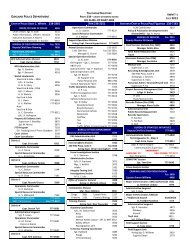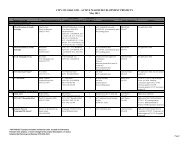Intelligent Transportation Systems - City of Oakland
Intelligent Transportation Systems - City of Oakland
Intelligent Transportation Systems - City of Oakland
Create successful ePaper yourself
Turn your PDF publications into a flip-book with our unique Google optimized e-Paper software.
design approaches can be developed while maintaining the benefits <strong>of</strong> a common<br />
architecture. The National ITS Architecture provides a standard vocabulary, a<br />
description <strong>of</strong> options to consider for local and regional ITS functions and activities, and<br />
a general set <strong>of</strong> tools to assist with systems integration. In addition, it identifies and<br />
specifies the requirements for the standards needed to support national and regional<br />
interoperability, as well as product standards needed to support economy <strong>of</strong> scale<br />
considerations in deployment. An architecture is not a design. Several different system<br />
designs or implementations can fit within the same architecture. An architecture defines<br />
the framework and functionality, while a design defines the specific plans for<br />
implementation.<br />
The National Architecture for ITS is essentially a tool to assist in the development <strong>of</strong><br />
specific architectures. The use <strong>of</strong> the National ITS Architecture reduces the time and<br />
costs required to develop architectures by providing a framework and process to follow.<br />
It allows for developing architectures in which future expansion, information exchange,<br />
and integration <strong>of</strong> systems (both existing and future) are inherent.<br />
There are two levels <strong>of</strong> architecture in the National ITS architecture model: regional<br />
architecture and project-level architecture. The Architecture Conformity Final Rule<br />
requires project-level architectures be developed for all ITS projects receiving federal<br />
funding and the project architectures must be consistent with a regional architecture. As<br />
mentioned in Section 2, MTC is currently in the process <strong>of</strong> developing the regional<br />
architecture for the San Francisco Bay Area. Hence, all future <strong>City</strong> <strong>of</strong> <strong>Oakland</strong> ITS<br />
projects should include a project architecture in the design documentation. Also, the<br />
project architecture should be based on the existing regional architecture (if one exists)<br />
and be provided to MTC so that the regional architecture can be updated to reflect the<br />
new <strong>City</strong> <strong>of</strong> <strong>Oakland</strong> ITS project.<br />
5.2 ITS USER SERVICES, SUBSYSTEMS AND MARKET PACKAGES<br />
One function <strong>of</strong> the National ITS Architecture documentation is to provide a common<br />
vocabulary for the development <strong>of</strong> individual system architectures around the nation.<br />
The basic building blocks <strong>of</strong> this architecture are user services, subsystems and market<br />
packages.<br />
User services document what ITS should do from the user's perspective. A broad range<br />
<strong>of</strong> users are considered, including the traveling public as well as many different types <strong>of</strong><br />
system operators. Thirty-one user services formed the basis for the National ITS<br />
Architecture development effort.<br />
Based on the results <strong>of</strong> the <strong>City</strong> workshop, the <strong>City</strong> <strong>of</strong> <strong>Oakland</strong>’s architecture will consist<br />
<strong>of</strong> the following seven user services as detailed in the National Architecture:<br />
• Pre-Trip Travel Information<br />
• Traffic Control<br />
• Incident Management<br />
• Highway-rail Intersection<br />
• Public <strong>Transportation</strong> Management<br />
• En-Route Transit Information<br />
• Emergency Vehicle Management<br />
<strong>City</strong> <strong>of</strong> <strong>Oakland</strong> ITS Strategic Plan<br />
56 September, 2003







